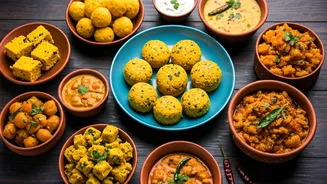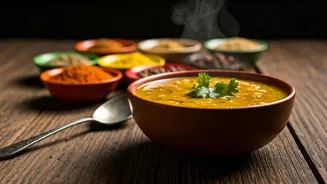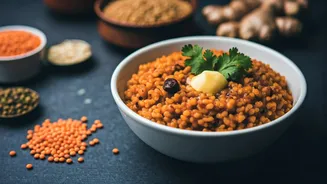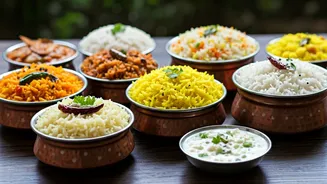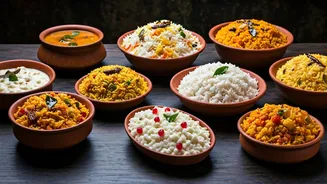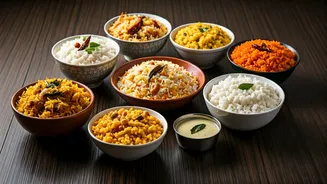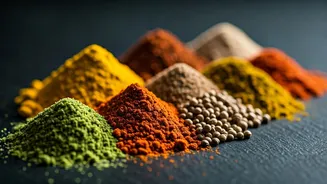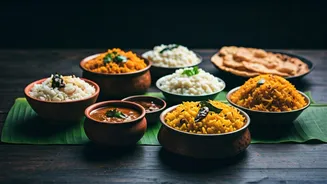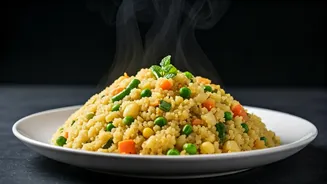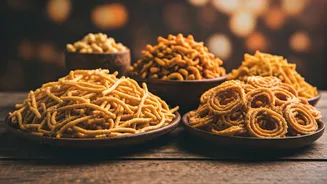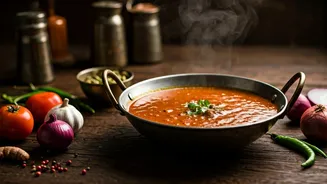Dhokla: The Delightful Snack
Dhokla is a steamed savoury cake that is a staple in Gujarati households. This dish is made from a fermented batter of gram flour (besan) and is known
for its light, fluffy texture. Typically, dhokla is seasoned with mustard seeds, green chillies, and curry leaves, providing a tangy and mildly spicy flavour. It is often served with a sweet and sour chutney or a green coriander chutney. The fermentation process gives dhokla its characteristic slightly sour taste, making it a refreshing and easily digestible snack. Dhokla is not just popular in Gujarat but across India, loved for its simple preparation and satisfying taste. Its versatility allows for variations, incorporating different spices or ingredients to suit individual preferences. The dish is ideal for breakfast, as a snack, or as a side dish during meals, making it a beloved part of Gujarati culinary traditions. The dish is perfect for any occasion!
Undhiyu: A Winter Specialty
Undhiyu is a mixed vegetable casserole that is traditionally cooked upside down in earthen pots, giving it its name, which means 'upside down' in Gujarati. This winter speciality features a blend of seasonal vegetables like eggplant, potatoes, green beans, and more, cooked in a mix of aromatic spices and herbs. The vegetables are carefully layered with a unique mixture of muthias (small dumplings made from gram flour) and cooked slowly, allowing the flavours to meld beautifully. Undhiyu often includes a mix of green garlic, ginger, and green chillies, adding a warming and spicy note to the dish. This dish is often served with puri and shrikhand, making it a festive meal enjoyed during special occasions, particularly during the winter months. Undhiyu embodies the essence of Gujarati cooking, focusing on fresh, seasonal ingredients and intricate flavour combinations.
Thepla: A Flatbread Delight
Thepla is a soft and flavorful flatbread, a popular breakfast or snack option in Gujarati cuisine. Made from whole wheat flour, gram flour, and various spices like turmeric, red chilli powder, and coriander, thepla is known for its distinctive flavour profile. Often, methi (fenugreek) leaves are added to the dough, giving the thepla a subtle bitter taste and aromatic fragrance. The dough is rolled into thin flatbreads and cooked on a griddle with a touch of oil. Thepla is often packed for travel due to its longevity, making it a convenient option. Thepla can be enjoyed on its own or with accompaniments like yogurt, pickles, or chutneys. It is a staple in Gujarati homes, appreciated for its simplicity and the ability to combine nutritional value with delicious taste. It's a versatile dish, perfect for any meal or snack.
Khandvi: Rolled Delicacy
Khandvi is a delicate, bite-sized snack made from a batter of gram flour (besan) and buttermilk. The batter is cooked on a griddle until it thickens, then spread thinly and rolled into small, elegant pinwheels. The rolls are seasoned with mustard seeds, curry leaves, and sometimes sesame seeds, adding a textural and flavourful contrast. Khandvi is known for its light, melt-in-your-mouth texture, which requires careful preparation. It offers a subtle flavour, with the tanginess of the buttermilk beautifully balancing the savoury spices. Garnishing with fresh coriander leaves provides a refreshing touch. Khandvi is a popular dish served during festivals and family gatherings, appreciated for its sophisticated appearance and delightful taste. The preparation of khandvi demonstrates the care and attention to detail that is often seen in Gujarati cooking. It is a true culinary art form.
Handvo: Savory Cake
Handvo is a savoury cake made from a batter of lentils and rice, along with vegetables and spices. This baked dish is a hearty and satisfying meal. The batter is prepared by fermenting a mix of lentils and rice, and then blending it with a variety of vegetables like bottle gourd, carrots, and peas. The addition of spices such as ginger, green chillies, and turmeric enhances the flavour. Handvo is usually baked until golden brown and is often served with green chutney or yogurt. It is a popular dish for lunch or dinner, providing a balance of nutrition and taste. Handvo's preparation combines the principles of fermentation with the addition of seasonal vegetables, making it a delicious and wholesome meal option. Its versatility and satisfying nature make it a beloved dish.
Dal Dhokli: Comforting Meal
Dal Dhokli is a wholesome and comforting one-pot meal that combines the goodness of lentils (dal) and small, wheat flour dumplings (dhokli). This dish begins with a flavourful lentil soup base, seasoned with spices like turmeric, asafoetida, and cumin. The dhokli is made by kneading wheat flour with spices and then boiling them in the dal, which allows the dumplings to absorb the flavors. Dal Dhokli is a balanced dish, combining protein from the lentils and carbohydrates from the dhokli. The slow cooking process allows the flavors to meld beautifully, creating a hearty and satisfying meal. Often garnished with coriander leaves and a squeeze of lemon juice, Dal Dhokli is particularly cherished during the cooler months, as it is a nourishing and comforting food option, ideal for both lunch and dinner.
Khichdi: Simple and Nutritious
Khichdi is a simple yet nutritious dish made from rice and lentils, and it’s a staple in many Indian households, including Gujarat. It's a light and easily digestible meal, often recommended when feeling unwell. Khichdi typically includes rice and yellow lentils (moong dal), cooked with turmeric, cumin, and other spices. It is often served with a dollop of ghee (clarified butter), which enhances the flavour and adds richness. Khichdi can be customized by adding vegetables or different types of lentils to vary the flavour and nutritional content. This adaptability makes khichdi a very versatile and easy-to-prepare meal. It’s perfect for both everyday meals and for those seeking a light, healthy option.
Sev Tameta Nu Shaak
Sev Tameta Nu Shaak is a tangy and mildly spicy tomato and sev-based curry, a popular dish from Gujarat. The dish features a tomato-based gravy, enhanced with a blend of spices, including turmeric, cumin, and mustard seeds. Fine sev (crispy gram flour noodles) is added towards the end of the cooking process, adding texture and flavour. The tangy flavour comes from the tomatoes, and the spices create a balanced taste. The sev absorbs the flavours of the curry, giving each bite a unique taste. Sev Tameta Nu Shaak is often served with roti or rice. Its ease of preparation and its delicious taste make it a frequently enjoyed dish in Gujarati cuisine. The addition of sev offers a delightful textural contrast that enhances the overall culinary experience.
Basundi: Sweet Delight
Basundi is a rich and creamy dessert, similar to rabri, made by thickening milk with sugar and cardamom. This dessert is prepared by slowly simmering milk until it reduces to a thick consistency, caramelizing the milk sugars and developing a rich flavour. The addition of sugar, cardamom, and nuts like almonds and pistachios enhances the flavour. Basundi is often served chilled, making it a refreshing dessert option. It is a popular choice during festivals and special occasions in Gujarat, celebrated for its smooth texture and sweet taste. The slow cooking process and the careful selection of ingredients create a delicious and satisfying dessert that is loved by all. It represents a delightful end to any meal.
